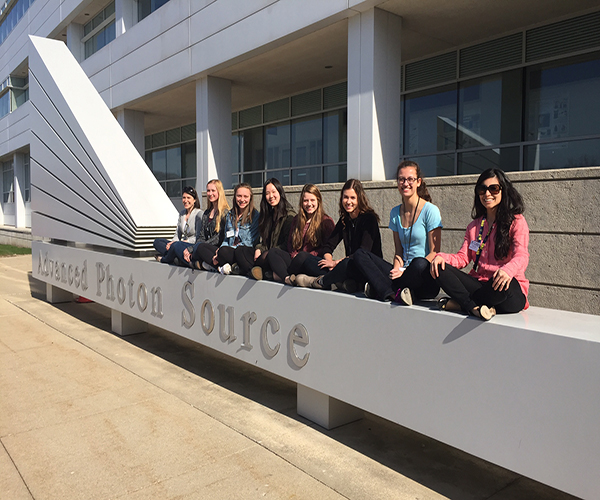STEM classes promote female involvement

Photo courtesy of Jill Serling
Women at Work: Six juniors along with science teachers Jill Serling and Lisa Pavic sit outside the Advanced Photon Source building of the Argon National Laborarory on April 14. The women attended a conference that encourages women to get involved in STEM fields and gives aspiring scientists a look into the real world of science.
April 22, 2016
If you are a woman pursuing an interest in a STEM (science, technology, engineering and mathematics) field, chances are you have been outnumbered by males in a related class, club or occupation at some point during your involvement. According to a statistic published by the United States Census Bureau in 2011, “26 percent of STEM workers were women and 74 percent were men.”
The topic of women in STEM has gained momentum over the past decade or so, as organizations and institutions such as the Office of Science and Technology Policy (OSTP), a department of the US Government, and the American Association of University Women have attempted to encourage women to break down barriers in STEM fields.
The OSTP stated that supporting women in STEM is “an essential part of America’s strategy to out-innovate, out-educate and out-build the rest of the world”. Whitehouse.gov identifies an inequality in the number of females and males involved in the field.
Senior Kayli Fradin, who is heavily involved in engineering courses at South, has noticed this imbalance in the ratio of girls to boys the OSTP identifies on a smaller scale within her classes at South.
“Within the engineering classes I’ve been involved in since sophomore year, I was one of two or three girls in my class,” Fradin said. “[Two years later], this is still how my classes are today, and my engineering class is pretty large [this year].”
Chemistry Teacher Jill Serling, who is currently pursuing a master’s degree in chemistry, notices the same sort of inequality in the amount of women in science within her advanced courses.
“While I was used to a 50-50 [ratio of females to males during my undergraduate years], in my master’s program for chemistry, there is about 20 percent girls,” Serling said. “That’s kind of a further idea of [the demographic in] higher science degrees…It’s still not prevalent to have an equal male to female ratio.”
Fradin feels as if this imbalance of women in STEM, specifically in engineering, roots from a lack of role models for young girls involved in science to look up to.
“There’s no specific person that comes to mind, versus when you think of men, you think of Bill Gates of Microsoft, or someone like that,” Fradin said.
The lack of STEM-involved female role models in the media reflects the issue Fradin discusses. The OSTP reported that in portrayals of computer scientists and engineers in family films, men outnumber women 14.25 to 1, according to whitehouse.gov. In an attempt to combat this gender imbalance in engineering on a local level, Fradin holds a mentor position in the Society of Women Engineers Club at South.
“[The club’s] main focus for this year has been ways we can spread the word about why women should be engineers and why it should not be a male-dominated occupation,” Fradin said. “We’ve been focusing more on trying to reach out to middle schools and [especially] telling girls about why they should join this club…which is so important, especially [because] there’s a lack of them in the field.”
Serling, like Fradin, believes having role models in STEM is important for students who aspire to have a career in a related field. On April 14, Serling took a group of six girls to the annual Science Careers in Search of Women Conference at Argonne National Laboratory— a tradition she brought to South and has spearheaded since 2012. During the event, which is centered around encouraging females to get involved in STEM fields, students have the opportunity to interact with female scientists as they engage in Q&A sessions and career-related discussions.
“Young female scientists are often there…[which] shows [students] that ‘Wow I could do that, that could be me in six years or so,’” Serling said. “I think it’s very inspirational for [students] to see somebody that is similar to them in a position they could potentially hold.”
Serling also believes that a huge component in women staying involved in science on their chosen career path is the support they receive. She urges students to overcome potential hardships by establishing support systems that will push them through difficulties in coursework or anywhere else in academia. In situations of adversity, she urges females to stick with their interests, even in situations in which they are outnumbered, and find their niche amongst male peers.
“Be yourself,” Serling said. “You’ll find where you fit in—and it doesn’t necessarily have to be that you’re friends with other males, but there are plenty of males in the field that accept you for everything you are anyways.”


